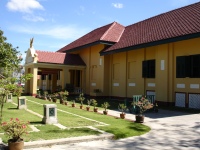 After nearly 3 months of downtime, the website amphoe.com has suddenly come back to life. When I last checked for it mid-December the nameserver was still not responding and thus the site inaccessible, but now yesterday it worked again. Thus apparently the administrator of the nameserver managed to switch it on again, and the website reappeared as nothing ever happened.
After nearly 3 months of downtime, the website amphoe.com has suddenly come back to life. When I last checked for it mid-December the nameserver was still not responding and thus the site inaccessible, but now yesterday it worked again. Thus apparently the administrator of the nameserver managed to switch it on again, and the website reappeared as nothing ever happened.Thus the content is the same as before, most notable there are still no entries for the district Galyani Vadhana created one year ago, and even Wiang Kao created in 2006 is still not present. The names of the district officers are more up-to-date, yet the last reshuffle from January 2010 wasn't added yet - for Mueang Surat Thani district amphoe.com still lists Chonosak Wanitcharoen(ชลอศักดิ์ วาณิชย์เจริญ), who is now permanent secretary of Surat Thani province.
Now the site is still working again, maybe I should make a complete mirror for myself, as the next critical point will be the expiry of the domain registration on January 15 - hopefully this time the administrator does the extension early enough and the domain does not fall to a domain grabber. But even then, the site will still be there under the IP address 115.31.184.25 until the actual webserver will be switched off.








